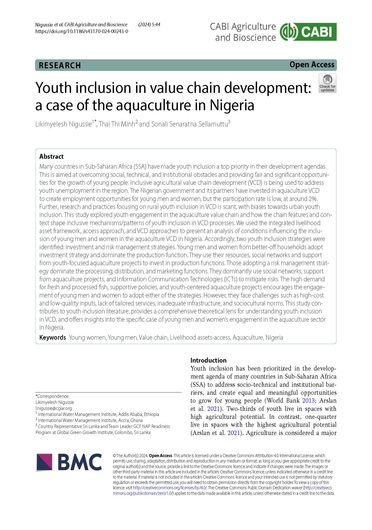Youth inclusion in value chain development: a case of the aquaculture in Nigeria
Abstract
Many countries in Sub-Saharan Africa (SSA) have made youth inclusion a top priority in their development agendas. This is aimed at overcoming social, technical, and institutional obstacles and providing fair and significant opportunities for the growth of young people. Inclusive agricultural value chain development (VCD) is being used to address youth unemployment in the region. The Nigerian government and its partners have invested in aquaculture VCD to create employment opportunities for young men and women, but the participation rate is low, at around 2%. Further, research and practices focusing on rural youth inclusion in VCD is scant, with biases towards urban youth inclusion. This study explored youth engagement in the aquaculture value chain and how the chain features and context shape inclusive mechanisms/patterns of youth inclusion in VCD processes. We used the integrated livelihood asset framework, access approach, and VCD approaches to present an analysis of conditions influencing the inclusion of young men and women in the aquaculture VCD in Nigeria. Accordingly, two youth inclusion strategies were identified: investment and risk management strategies. Young men and women from better-off households adopt investment strategy and dominate the production function. They use their resources, social networks and support from youth-focused aquaculture projects to invest in production functions. Those adopting a risk management strategy dominate the processing, distribution, and marketing functions. They dominantly use social networks, support from aquaculture projects, and Information Communication Technologies (ICTs) to mitigate risks. The high demand for fresh and processed fish, supportive policies, and youth-centered aquaculture projects encourages the engagement of young men and women to adopt either of the strategies. However, they face challenges such as high-cost and low-quality inputs, lack of tailored services, inadequate infrastructure, and sociocultural norms. This study contributes to youth inclusion literature, provides a comprehensive theoretical lens for understanding youth inclusion in VCD, and offers insights into the specific case of young men and women’s engagement in the aquaculture sector in Nigeria.

